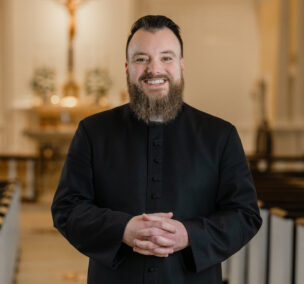Dear Brothers and Sisters in Christ,
As we celebrate the conclusion of the Octave of Easter with Divine Mercy Sunday, we are reminded that the Resurrection is profoundly a mystery of God’s mercy. I hope that you will join us at 3 PM to pray the Chaplet of Divine Mercy here in the church. This chaplet was given to St. Faustina Kowalska and has become a very popular devotion all over the world.
I’d like to use my remaining space to give some further insight and context to the beautiful liturgies of the Triduum and Easter Sunday. As you know, the Triduum represents the Catholic Church’s holiest days. The liturgy of the Triduum, leading to the Easter Vigil, has a particular character and calls for certain practices and details that we do not necessarily see every week. These details help remind us that what we celebrate during Holy Week is unique and solemn.
One of the most noticeable elements used during the Triduum, particularly on Holy Thursday, is incense. The use of incense in religious rituals has been widespread, historically. Jewish worship in the Temple called for the offering of incense, echoing Psalm 141: “Let me prayer arise before you like incense, the raising of my hands like an evening oblation.” Incense symbolizes our prayers rising to God. Additionally, it is symbolic of inner purification of our hearts and minds, as well as the purification of the space in which we worship. The rubrics (the instructions contained in liturgical books explaining what and how to carry out liturgical action) for the Mass of the Lord’s Supper on Holy Thursday call for incense to be used frequently. Likewise, the Easter Vigil’s rubrics instruct us to use incense at certain places. Outside of Holy Week, incense is used mainly on Sundays (when possible, if sufficient altar servers are available), for solemn celebrations such as Benediction, and for funerals.
Another interesting piece of liturgical equipment is called the crotalus, and is used only during the Triduum. From the Gloria on Holy Thursday to the Gloria at the Easter Vigil, bells are not rung in church, nor are instruments usually played. The crotalus is a wooden clapper and is used at the consecration in place of bells, and at the start of the Good Friday liturgy indicating that the congregation should stand. This simple piece of wood is then put away for the remainder of the year.
With Easter comes the renewal of baptismal promises. This renewal is accompanied by a sprinkling rite, in which the priest sprinkles the congregation with holy water. Just as our use of holy water when entering or exiting the church is a symbolic reminder of our baptism, so the sprinkling rite after the renewal of baptismal promises is meant to remind us that, having been baptized, we have been made one with Christ and called to be His disciples. If you think the priest is aiming just for you with the holy water, he probably is.
The greatest buzz surrounding Holy Week and Easter, though, was a piece of clerical haberdashery called the biretta. The biretta is a hat, usually with a tassle or pom, and three peaks (in academic use, four peaks indicates a doctoral degree), once a regular part of a priest’s daily garb. Over the years, the biretta also came to be used in the context of the liturgy and was worn in processions, when the priest was seated, and optionally, when the priest preached. The priest removes the biretta if genuflecting, reciting a prayer, or performing some other action at the altar. Priests sitting in choir remove the biretta at the mention of the Holy Name of Jesus. While currently there is no requirement for the use of birettas, they add a symbolic degree of solemnity to our liturgical celebrations. It’s also a great conversation starter. You can expect to see us use birettas from time to time for solemnities or feasts that are especially important.
If there are any other liturgical details you’ve noticed, please feel free to ask about them. The Catholic liturgy is rich in symbolism, and the more we understand of those powerful signs the more we are able to enter into the mysteries they represent and serve!
Peace,
Fr. Sam


